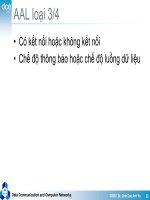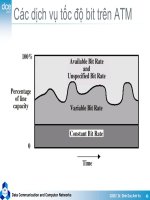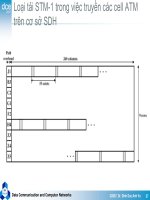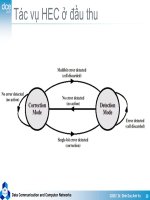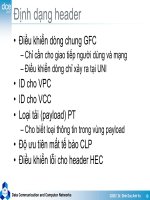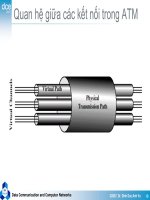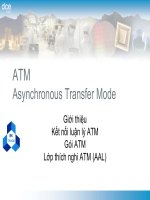Digital (kỹ THUẬT TRUYỀN số LIỆU SLIDE)
Bạn đang xem bản rút gọn của tài liệu. Xem và tải ngay bản đầy đủ của tài liệu tại đây (419.85 KB, 35 trang )
Digital Transmission
Outline
Line coding
Encoding considerations
DC components in signals
Synchronization
Various line coding methods
2
Line Coding
Process of converting binary data to digital signal
3
Signal Levels vs. Data Levels
Number of signal levels
Number of different voltage levels allowed in a signal
Number of data levels
Number of voltage levels that actually represent data values
4
Signal vs. Data Elements
5
Pulse Rate vs. Bit Rate
+3
00
11
01
10
01
10
11
00
+1
t
-1
-3
One pulse
(one signal element)
BitRate = PulseRate × b = PulseRate × log2L
BitRate = PulseRate × b = PulseRate × log2L
b – number of bits per pulse
L – number of different signal elements
Bit rate → Bits per second
Bit rate → Bits per second
Pulse rate → Baud (pulses or signals per second)
Pulse rate → Baud (pulses or signals per second)
6
Pulse Rate vs. Bit Rate
Example: In Manchester Encoding, if the bit rate is
10 Mbps, what is the pulse rate?
0
1
0
0
1
1
0
1
t
One bit
One pulse
(one signal element)
7
Encoding Considerations
Signal spectrum
Lack of DC components
Lack of high frequency components
Clocking/synchronization
Error detection
Noise immunity
Cost and complexity
8
DC Components
DC components in signals are not desirable
Cannot pass thru certain devices
Leave extra (useless) energy on the line
0
1
0
0
1
1
0
1
Signal with
t
0
1
0
0
1
1
0
DC component
1
Signal without
t
DC component
9
Synchronization
To correctly decode a signal, receiver and sender must agree on
bit interval
0
1
0
0
1
1
0
1
Sender sends:
01001101
t
0
1
0
0
0
1
1
0
1
1
Receiver sees:
0100011011
t
10
Providing Synchronization
Separate clock wire
data
Sender
Receiver
clock
Self-synchronization
0
1
0
0
1
1
0
1
t
11
Line Coding Methods
Unipolar
Uses only one voltage level (one side of time axis)
Polar
Uses two voltage levels (negative and positive)
E.g., NRZ, RZ, Manchester, Differential Manchester
Bipolar
Uses three voltage levels (+, 0, and –) for data bits
Multilevel
12
Unipolar
Simplest form of digital encoding
Rarely used
Only one polarity of voltage is used
E.g., polarity assigned to 1
0
1
0
0
1
1
0
0
t
13
Polar Encoding
Two voltage levels (+,-) represent data bits
Most popular four
Nonreturn-to-Zero (NRZ)
Return-to-Zero (RZ)
Manchester
Differential Manchester
14
NRZ Encoding
Nonreturn to Zero
NRZ-L (NRZ-Level):
Signal level depends on bit value
0
1
0
0
1
1
1
0
t
1
0
0
1
1
1
0
NRZ-I0(NRZ-Invert):
Signal is inverted if 1 is encountered
N = Bit rate
Save = Average signal rate
t
15
RZ Encoding
Return to Zero
Uses three voltage levels: +, - and 0, but only + and - represent data
bits
Half way thru each bit, signal returns to zero
0
1
0
0
1
1
0
0
?
t
16
Manchester Encoding
Uses an inversion at the middle of each bit
For bit representation
For synchronization
0
1
0
0
1
1
0
=0
1
t
=1
17
Differential Manchester Encoding
The inversion on the middle of each bit is only for
synchronization
Transition at the beginning of each bit tells the value
0
1
0
0
1
1
0
1
t
18
Bipolar Encoding
Bipolar encoding uses three voltage levels: +, - and 0
Each of all three levels represents a bit
E.g., Bipolar AMI (Alternate Mark Inversion)
0V always represents binary 0
Binary 1s are represented by alternating + and -
0
1
0
0
1
1
0
1
t
19
BnZS Schemes
BnZS – Bipolar n-zero substitution
Based on Bipolar AMI
n consecutive zeros are substituted with some +/- levels
provides synchronization during long sequence of 0s
E.g., B8ZS
1
1
0
0
0
0
0
0
0
0
1
1
0
0
0
0
0
1
0
Bipolar
AMI
t
0
0
0
V
B
0
V
B
B8ZS
V – Bipolar violation
B – Valid bipolar signal
20
Other Schemes
mBnL
m data elements are substituted with n signal elements
E.g., 2B1Q (two binary, 1 quaternary)
+3
00
11
01
10
01
10
11
00
Bit sequence
Voltage level
00
-3
01
-1
10
+3
11
+1
+1
t
-1
-3
21
Multilevel: 8B6T
Eight binary, six ternary
22
Block Coding
Improves the performance of line coding
Provides
Synchronization
Error detection
Division
…01011010001…
Line
Substitution
:
Coding
0010
10110
1101
01011
0001
01010
:
t
:
:
23
4B/5B Encoding Table
Data
Code
Data
Code
Data
Code
0000
11110
1000
10010
Q (Quiet)
00000
0001
01001
1001
10011
I (Idle)
11111
0010
10100
1010
10110
H (Halt)
00100
0011
10101
1011
10111
J (start delimiter)
11000
0100
01010
1100
11010
K (start delimiter)
10001
0101
01011
1101
11011
T (end delimiter)
01101
0110
01110
1110
11100
S (Set)
11001
0111
01111
1111
11101
R (Reset)
00111
24
Analog to Digital Conversion
Pulse Amplitude Modulation (PAM)
Converts an analog signal into a series of pulses by sampling
PAM
Analog signal
PAM signal
(Sampled analog data)
25



